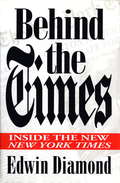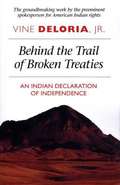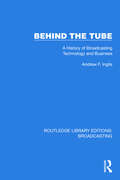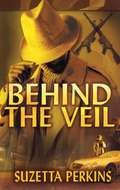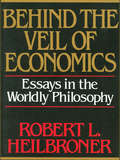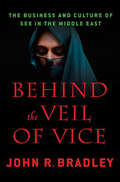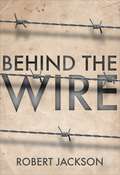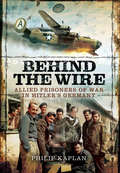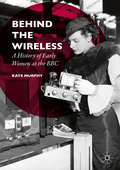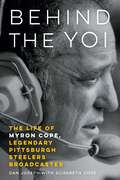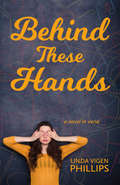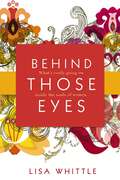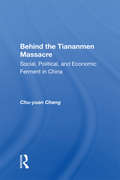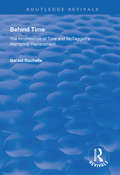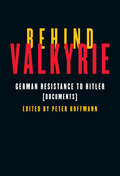- Table View
- List View
Behind the Times: Inside the New New York Times
by Edwin DiamondAn incisive examination of the world's most respected paper, Behind the Times tells the story of changing Timesian values and of a new era for the paper--a tale of editorial struggles, star columnists and critics, institutional self-importance, and the political and cultural favorites of the Times' owners and editors. Taking the reader inside the Times' newsrooms and executive offices, Diamond offers an expert, insider's appraisal of how the Times and its editors continue to shape coverage of major public events for over one million readers. Diamond goes behind the scenes to recount the paper's recent and much heralded plan to win larger audiences and hold on to its dominant position in the new media landscape of celebrity journalism and hundred-channel television.
Behind the Trail of Broken Treaties: An Indian Declaration of Independence
by Vine Deloria Jr.Originally published in 1974, just as the Wounded Knee occupation was coming to an end, Behind the Trail of Broken Treaties raises disturbing questions about the status of American Indians within the American and international political landscapes. Analyzing the history of Indian treaty relations with the United States, Vine Deloria presents population and land ownership information to support his argument that many Indian tribes have more impressive landholdings than some small members of the United Nations. Yet American Indians are not even accorded status within the UN's trust territories recognition process. A 2000 study published by the Annual Survey of International and Comparative Law recommends that the United Nations offer membership to the Iroquois, Cherokee, Navajo, and other Indian tribes. Ironically, the study also recommends that smaller tribes band together to form a confederation to seek membershipÑa suggestion nearly identical to the one the United States made to the Delaware Indians in 1778Ñand that a presidential commission explore ways to move beyond the Doctrine of Discovery, under which European nations justified their confiscation of Indian lands. Many of these ideas appear here in this book, which predates the 2000 study by twenty-six years. Thus, Behind the Trail of Broken Treaties anticipates recent events as history comes full circle, making the book imperative reading for anyone wishing to understand the background of the movement of American Indians onto the world political stage. In the quarter century since this book was written, Indian nations have taken great strides in demonstrating their claims to recognized nationhood. Together with Tribes, Treaties, and Constitutional Tribulations, by Deloria and David E. Wilkins, Behind the Trail of Broken Treaties highlights the historical events that helped bring these changes to fruition. At the conclusion of Behind the Trail of Broken Treaties, Deloria states: "The recommendations made in the Twenty Points and the justification for such a change as articulated in the book may well come to pass in our lifetime. " Now we are seeing his statement come true.
Behind the Tube: A History of Broadcasting Technology and Business (Routledge Library Editions: Broadcasting #5)
by Andrew F. InglisBehind the Tube (1990) tells the story of the unseen foundation of modern radio, TV and cable – the technology that enables programming to reach an audience. It charts the evolution of this technology in all its facets – technical, personal, economic and social. It captures the efforts, strategies, achievements and failures of prominent and unheralded figures and companies in the dynamic and competitive broadcast industry.
Behind the Veil
by Suzetta PerkinsThou shalt not steal, murder... Jefferson Myles embezzles money from the wealthy clients of his securities firm to fund "Operation Stingray," an organization that steals ammunition from military bases to sell to rebels in Honduras. His greed doesn't stop at the bank, though. Nor covet thy neighbor's wife. His beautiful neighbor Linda, with her silky skin and curvaceous hips? Yeah, she's his too. Until her husband, Blake, discovers his secrets -- and winds up dead. Now Jefferson's life is in danger, and the wife he turned his back on may be the only one who can save him.
Behind the Veil
by Joanna WayneSTEALTHY SEDUCTION Rumor had it that the secretive owner of the castle on the cliffs, Dr. David Bryson, had been hideously scarred in the accident that killed his fiancÉe. Now designer Becca Smith had been summoned to work in his home. Though she received mysterious warnings to stay away, nothing could keep Becca from meeting the man whose seductive voice made her burn for his touch. She was too young, too beautiful, too familiar. She awakened memories in David long buried. . . emotions that teetered on the edge of insanity. But he vowed to see Becca only from the shadows. Except when a killer attacked, David stepped from behind the veil of darkness to save the woman who was his only hope of salvation.
Behind the Veil of Economics: Essays in the Worldly Philosophy
by Robert L. Heilbroner"[These essays] are rich in argument, in clear and provocative presentation of complicated issues, and are often delightfully quotable. Behind the Veil of Economics makes instructive, disturbing, and lively reading." --Elizabeth Wolgast, New York Times Book Review What lies behind the veil of economics? Power and ideology, answers Robert Heilbroner--the power of our economic involvement in society to shape the ways we think about it; the visions and values that add unsuspected ideological color to our economic beliefs about it. Most important, Heilbroner shows why economics has become the reigning form of social inquiry and how we might penetrate its mystique.
Behind the Veil of Vice: The Business and Culture of Sex in the Middle East
by John R. BradleyThe Middle East has long been something of a mystery to Westerners, and in particular, the sexual mores of the region continue to fascinate. Arabs are often described as being in a state of Islam-induced sexual anxiety and young Muslims' frustrations are said to be exacerbated by increasing exposure to the licentiousness of the West. Here, Middle East expert John R. Bradley sets out to uncover the truth about sex in countries like Egypt, Syria, Morocco and Yemen. Among many startling revelations, Bradley reports on how "temporary" Islamic marriages allow for illicit sex in the theocracies of Iran and Saudi Arabia; "child brides" that are sold off to older Arab men according to ancient tribal traditions; the hypocrisy that undermines publicized crackdowns on the thriving sex industry in the Persian Gulf; and how, despite widespread denial, homosexuality is still deeply ingrained in the region's social fabric. Richly detailed and nuanced, Behind the Veil of Vice sheds light on a taboo subject and unravels widely held myths about the region. In the process, Bradley also delivers an important message about our own society's contradictions.
Behind the Wall: My Brother, My Family and Hatred in East Germany
by Ines GeipelGermany, like many countries, has witnessed the rise of extremist far-right groups and parties in recent years, and no more so than in the eastern regions. Why have those parts of Germany that used to be part of the old GDR turned out to be so supportive of extremist groups and parties and such fertile ground for violence and hatred? To try to find answers to this question, Ines Geipel, the former East German Olympic athlete, returns to her past in order explore the matrix of fear and anxiety that shaped the lives of people in the GDR. Spurred on by conversations at the bedside of her brother as he lay dying of a brain tumour, she probes into her own family background and discovers a web of secrets and denial that reflected larger processes of East German society. She finds that her father had worked as a special agent for the Stasi until the service had no further use for him, and her grandfather had joined the Nazi party in 1933 and was stationed in Riga at a time when tens of thousands of Jews were murdered in the nearby forests. Silence and denial within her family was mirrored in the collective loss of history outside her home, and the repression of ideological non-conformity made it difficult for a traumatized population to grapple with and come to terms with a brutal past. Instead, a politics of forgetting emerged which served the ends of an authoritarian state and seeped into private lives of individuals with deep and lasting consequences. This powerful memoir, grippingly told, will appeal to anyone interested in the history of modern Germany, in the rise of far-right extremism and xenophobia and in the historical forces that shape the present.
Behind the Walls of Terra
by Philip Jose FarmerBehind the walls of Terra lay a secret no man could be allowed to learn. But Kickaha - the Earth-born adventurer of the tiered worlds - had to uncover that secret, or watch his home world destroyed.Kickaha was returning to Earth from the World of Tiers, the many-levelled universe of the god-like Lords, that he had entered many years ago as Paul Janus Finnegan. Now he had returned to a world he no longer knew, to find it ruled by Red Orc, a Lord jealous of his personal domain and hostile to intruders. Yet Kickaha had to stay alive in order to defeat the deadly enemy that threatened Earth and the other worlds of tiers - the 'Beller', the malignant creature that was the mind-essence of a rebel Lord.
Behind the White Picket Fence
by Sarah Mayorga-GalloThe link between residential segregation and racial inequality is well established, so it would seem that greater equality would prevail in integrated neighborhoods. But as Sarah Mayorga-Gallo argues, multiethnic and mixed-income neighborhoods still harbor the signs of continued, systemic racial inequalities. Drawing on deep ethnographic and other innovative research from "Creekridge Park," a pseudonymous urban community in Durham, North Carolina, Mayorga-Gallo demonstrates that the proximity of white, African American, and Latino neighbors does not ensure equity; rather, proximity and equity are in fact subject to structural-level processes of stratification. Behind the White Picket Fence shows how contemporary understandings of diversity are not necessarily rooted in equity or justice but instead can reinforce white homeowners' race and class privilege; ultimately, good intentions and a desire for diversity alone do not challenge structural racial, social, and economic disparities. This book makes a compelling case for how power and privilege are reproduced in daily interactions and calls on readers to question commonsense understandings of space and inequality in order to better understand how race functions in multiethnic America.
Behind the Wire: Prisoners of War 1914-18
by Robert JacksonA unique story of POWs in World War I. Covering traumatic capture on the battlefield, internment in POW camps, escape attempts, punishments, day-to-day boredom and meagre rations, Behind the Wire is a gripping, comprehensive history of the remarkable experiences of POWs in the First World War. Opening with the desperate scene of the brutally cold, wind-swept POW camp at Wittenburg in December 1914, where 16,000 prisoners were dying in from exposure and malnutrition, Jackson weaves together official reports and first-hand accounts to reveal the immense challenges faced by all belligerent nations in housing their prisoners of war, and how the men behind the wire did all they could to survive and one day return home.
Behind the Wire: Allied Prisoners of War in Hitler’s Germany
by Philip KaplanPhilip Kaplan presents us here with a riveting account of the Allied experience behind enemy lines, detailing the trials and tribulations experienced by the British and American airmen who were shot down in European skies during World War Two, to be incarcerated 'behind the wire' in enemy camps. With eloquence and a clear enthusiasm for the subject at hand, the author describes how various individuals adjusted to their incarceration. Whilst some set their minds resolutely on escape, and dreamt up plots and plans to achieve this end, others retreated, away from their comrades and into themselves as the grim reality of their predicament pushed them ever deeper into debilitating depression. Others were determined that they would not waste their time; affected by the quick and brutal deaths they had witnessed during their wartime careers, they were unwilling to sit idle. Theatres, recreational areas, and other camp facilities were designed and built a creative spur that made their time behind the wire, and the quality of life of their fellow comrades, infinitely more bearable. These small acts of enterprising heroism, alongside the harrowing tales of those who crumpled under the weight of their prison reality, combine to create a complete picture of this collective experience. Kaplan's skill lies in informing the reader of the facts of this history with both honesty and reverence.
Behind the Wireless: A History of Early Women at the BBC
by Kate MurphyBehind the Wireless tells the story of women at the BBC in the 1920s and 30s. Broadcasting was brand new in Britain and the BBC developed without many of the overt discriminatory practices commonplace at the time. Women were employed at all levels, except the very top, for instance as secretaries, documentary makers, advertising representatives, and librarians. Three women held Director level posts, Hilda Matheson (Director of Talks), Mary Somerville (Director of School Broadcasting), and Isa Benzie (Foreign Director). Women also produced the programmes aimed at female listeners and brought women broadcasters to the microphone. There was an ethos of equality and the chance to rise through the ranks from accounts clerk to accompanist. But lurking behind the façade of modernity were hidden inequalities in recruitment, pay, and promotion and in 1932 a marriage bar was introduced. Kate Murphy examines how and why the interwar BBC created new opportunities for women.
Behind the Yellow Tape
by Jarrett Hallcox Amy Welch Patricia CornwellFrom the authors of Bodies We've Buried-an uncensored look at real-life CSIs. With a foreword by Patricia Cornwell. For years, Jarrett Hallcox and Amy Welch trained CSIs at the National Forensic Academy in Knoxville, Tennessee. Now they provide a glimpse into the real world of crime scene investigation, and the investigators themselves. Experience, through gripping text and photographs, eight gripping accounts of true crime from across the country: from the murky waters of the Puget Sound to the crumbling ruins of the Alamo and the grimy streets of the Big Apple, these are the real stories of the people who work behind the yellow tape.
Behind the Yoi: The Life of Myron Cope, Legendary Pittsburgh Steelers Broadcaster
by Dan Joseph Elizabeth CopeMyron Cope was the color commentator for Pittsburgh Steelers radio broadcasts from 1970 to 2005, the second-longest-serving team broadcaster in NFL history. At the peak of his popularity, an estimated 50 percent of Steeler fans turned down the volume on their TVs so they could listen to the radio as Cope, in his one-of-a-kind scratchy, raspy voice, barked out phrases like &“Yoi&” and &“Okle-dokle,&” often fueled by bursts of excitability and his own beautiful brand of homerism. About his voice, Cope said, &“Mine isn&’t a broadcaster&’s voice; it tends to cut through concrete.&” Cope helped forge the unbreakable bond between the city of Pittsburgh and its football team. His evening talk show, one of the first sports talk programs in the nation, dominated its time slot for more than twenty years, and he became the first pro football announcer elected to the National Radio Hall of Fame. Born in Pittsburgh to parents of Lithuanian Jewish ancestry, Cope attended the University of Pittsburgh and became a journalist. Though he forged a successful career writing for magazines like Sports Illustrated, football fans grew to know Cope far more through the airwaves. Co-namer of the Immaculate Reception, he also created the Terrible Towel, the flag of Steelers Nation, when in 1975 he urged fans to bring gold towels to wave at a playoff game against the Baltimore Colts. Behind the scenes the Terrible Towel took on a deeper personal meaning, as Cope eventually assigned all royalties from the towels to the facility where his son, who was born with brain damage and never learned to speak, still resides. Throughout his life Cope, who passed away in 2008, raised hundreds of thousands of dollars for children with disabilities. Using Cope&’s own papers, correspondence, and tapes, plus interviews with friends and family, Dan Joseph and Elizabeth Cope, Myron&’s daughter, paint the first three-dimensional portrait of the creative, many-faceted man whom Pittsburghers still hold in high esteem and close to their hearts.
Behind Their Screens: What Teens Are Facing (and Adults Are Missing)
by Emily Weinstein Carrie JamesHow teens navigate a networked world and how adults can support them.What are teens actually doing on their smartphones? Contrary to many adults&’ assumptions, they are not simply &“addicted&” to their screens, oblivious to the afterlife of what they post, or missing out on personal connection. They are just trying to navigate a networked world. In Behind Their Screens, Emily Weinstein and Carrie James, Harvard researchers who are experts on teens and technology, explore the complexities that teens face in their digital lives, and suggest that many adult efforts to help—&“Get off your phone!&” &“Just don&’t sext!&”—fall short. Weinstein and James warn against a single-minded focus by adults on &“screen time.&” Teens worry about dependence on their devices, but disconnecting means being out of the loop socially, with absence perceived as rudeness or even a failure to be there for a struggling friend. Drawing on a multiyear project that surveyed more than 3,500 teens, the authors explain that young people need empathy, not exasperated eye-rolling. Adults should understand the complicated nature of teens&’ online life rather than issue commands, and they should normalize—let teens know that their challenges are shared by others—without minimizing or dismissing. Along the way, Weinstein and James describe different kinds of sexting and explain such phenomena as watermarking nudes, comparison quicksand, digital pacifiers, and collecting receipts. Behind Their Screens offers essential reading for any adult who cares about supporting teens in an online world.
Behind these Doors: Stories of Strength, Suffering and Survival
by Alex SouthA powerful and affecting look at life in prisonThe men I have worked with and the staff I've worked alongside over the last ten years in prison have taught me strength, compassion, courage, and fundamentally, the need to talk, the need to share and the need to tell these stories. These are the stories of lives lived, lost and taken, behind walls so high we can pretend they hide another world entirely. But at what cost?__________Behind These Doors is a provocative, insightful and illuminating interrogation of what it is to live and to work in the UK's most infamous prisons. The individuals Alex introduces us to are, for the most part, living on the margins of society and the impact of the cycles of violence that so often accompany those lives is clear to see. Alex takes us by the hand, behind the gates and through security into prison cells, to the shared kitchens, the prison library, down the corridors and into the 'seg' (segregation unit); we will meet men who will surprise and shock us in equal measure, as well as prison officers who struggle to contain the challenges the job presents.This is a no holds barred depiction of life in prison and its many devastating and astonishing, and sometimes inspiring, consequences. As a woman in this environment, her perspective feels especially urgent.(P) 2023 Hodder & Stoughton Limited
Behind these Doors: Stories of Strength, Suffering and Survival
by Alex South*Out now: a powerful and affecting look at prison and the devastating impact it can have*'A true, compassionate and honest account of what it is to work in our prisons.' Dr Gwen Adshead, Sunday Times bestselling author of The Devil You Know'A vivid, unsentimental insight into a world that needs to be seen . . . a powerful reminder of how far we are from rehabilitating our prisons.' The Observer'This is a beautifully written account about hope and optimism, of humanity, realism, resilience and the complexity of people.' Professor David Wilson__________'The men I have worked with and the staff I've worked alongside over the last ten years in prison have taught me strength, compassion, courage, and fundamentally, the need to talk, the need to share and the need to tell these stories. These are the stories of lives lived, lost and taken, behind walls so high we can pretend they hide another world entirely. But at what cost?Few people leave prison unchanged. It's a place heavy with suffering, a place where you will find dangerous, vulnerable, and forgotten people. But for Alex South, it was a place where she also found hope.In this powerful and moving memoir, Alex attempts to make sense of her experiences in prison by confronting the harsh reality of life on the inside and examining them from different angles. In an overwhelmingly masculine environment, where strength and aggression are routinely on show, Alex's view is particularly important.Capturing the confusion and contradictions of prison, Alex presents a life that is often hidden from the public. Changing our perceptions, Behind These Doors shows the many devastating, but often inspiring, consequences prison can have.__________'I was completely gripped whilst reading it - it's such a powerful memoir and one that shines a light into a world most of the public rarely see.' Nikki Smith, author of The Beach Party
Behind These Hands
by Linda Vigen Phillips"A richly woven, unforgettable symphony of feelings and words" –Kirkus Reviews (Starred Review)Piano prodigy Claire Fairchild, 14, has always known music would be her life. So when she has the opportunity to enter a prestigious contest, she goes all in—until she realizes she’s also competing against Juan, a close childhood friend and one of the most talented musicians she knows. It doesn’t help that her thoughts about him are turning romantic.When Claire and her family receive a devastating blow from Batten disease, her world enters a tailspin. Claire decides her musical goals no longer seem relevant.She can’t reconcile the joy that music would bring to her life while her brothers succumb to an early and ugly death. Her decision puts everything at risk: her friendship with Juan, her parents’ expectations, and her own happiness.After Claire accompanies a friend on a school newspaper assignment, she meets a centenarian with a surprising musical past and only one regret in life. Claire knows something in her life has to change before it’s too late, but she’s not sure she has the courage to take the next step.
Behind Those Eyes: What's Really Going on Inside the Souls of Women
by Lisa WhittleMeet the cast. Ms. Perfection, Ms. Confidence, Ms. Happiness, Ms. Spirituality. Do you know them? Maybe, if you're honest with yourself, you may recognize you are one of them.Let's admit it: the stories behind our eyes often go untold. We tend to cover our insecurities and heartaches with engaging smiles, fashionable clothes, and manufactured conversations. We impersonate the women we want to be - deeply spiritual, caring, supportive, capable, put together, and ridiculously happy. We desperately want to be accepted and loved, but we're afraid to reveal our true selves to others.In Behind Those Eyes, Bible teacher and speaker Lisa Whittle encourages women to get real - real with ourselves, real with one another, and real before God. With humor, compassion, and biblical insight, Whittle takes a refreshingly honest look at how we often mask our fear of rejection. In this book you learn how to:See your impersonations for what they really areFree yourself from shallow interactions with othersLearn to choose authenticity over pretensePractice truth as a healing agent in your relationships
Behind The Tiananmen Massacre: Social, Political, And Economic Ferment In China
by Chu-yuan ChengThe 1989 prodemocracy movement in the People's Republic of China and the subsequent crackdown were marked by many dramatic reversals. Supported at first by several thousand Beijing University students, the movement quickly attracted millions of followers and developed into a nationwide mass movement. The jubilant mood during the short-lived freedom in Tiananmen Square turned into despair over the unnecessary bloodshed. The event raised many deeply disturbing questions: Was the massacre necessary and justified? What is the historical significance of this movement? Which path will the PRC follow in the decade ahead? Although no one had anticipated the tragic outcome, the popular unrest was not totally unexpected. When I read the news of 200,000 Beijing students and residents, in open defiance of the government's order, staging a largescale demonstration on Apri120, I knew a confrontation between the people and the government was inevitable.
Behind Time: Incoherence of Time and McTaggart's Atemporal Replacement (Routledge Revivals)
by Gerald RochelleFirst published in 1998, this volume responded to and evaluated criticisms of McTaggart’s atemporal philosophy of time. Established philosophical positions on time had positioned themselves in relation to either the A Series (past, present and future) or the B Series (earlier and later). McTaggart considered both series untenable and proposed his own, atemporal C Series. Beginning with an overview of McTaggart’s position, Gerald Rochelle attempts to reinforce the seriousness of, and think beyond, McTaggart’s attempt to describe a world without time through an assessment of McTaggart’s criticisms and his suggested alternative. Rochelle argues that McTaggart’s atemporal world constitutes a strong foundation for a new theory on time which breaks away from the existing philosophical models of temporality.
Behind The Urals: An American Worker In Russia’s City Of Steel (Russia Observed Ser.)
by John ScottJohn Scott left the University of Wisconsin for the Soviet Union in 1931. Appalled by the depression and attracted by what he had heard concerning the effort to create a "new society" in the Soviet Union, he obtained training as a welder and went abroad to join the great crusade. Assigned to construction of the new "Soviet Pittsburgh," Magnitogorsk, on the eastern slopes of the Ural Mountains, the twenty-year-old was first an electric welder and then a foreman and chemist in a coke and chemicals by-products plant. He lived in a barracks, suffered cold and privation, studied evenings, married a Russian girl--in short, lived for five years as a Russian among Russians.No other description of life in a new steel city provides such a graphic description of the life of workers under the First Five Year Plan. Scott had a clear eye for detail and produced a chronicle that includes the ugliness and squalor as well as the endurance and dedication. Behind the Urals stands as a unique and revealing description of an iron age in an iron country.-Print ed."Students reading Scott have come away with a real appreciation of the hardships under which these workers built Magnitogorsk and of the nearly incredible enthusiasm with which many of them worked."--Ronald Grigor Suny"A genuine grassroots account of Soviet life- a type of book of which there have been far too few."--William Henry Chamberlin, New York Times, 1943 "...a rich portrait of daily life under Stalin."--New York Times Book Review
Behind Valkyrie
by Peter HoffmannWhile the "Valkyrie" plot by Nazi officers to kill Adolf Hitler is the best known instance of German opposition to his dictatorship, there were many other significant acts of resistance. Behind Valkyrie collects documents, letters, and testimonies of Germans who fought Hitler from within, making many of them available in their entirety and in English for the first time. Peter Hoffmann assembles the words of citizens protesting the National Socialists' dismantling of the first democratic German republic, socialists and conservatives arguing for civil liberties, and dissatisfied senior military officials. Behind Valkyrie's first-hand accounts of reactions to crimes by the SS, mistreatment of millions of Soviet prisoners of war, mass murder of Jews, and the mismanagement of military campaigns show that attempts to maintain freedom, justice, and human rights often came from unexpected sources. While not free of the prejudices of their time, these nearly forgotten voices help provide a more complete understanding of the range of dissent during one of history's most disturbing epochs.
Behind Valkyrie: German Resistance to Hitler, Documents
by Peter HoffmannWhile the "Valkyrie" plot by Nazi officers to kill Adolf Hitler is the best known instance of German opposition to his dictatorship, there were many other significant acts of resistance. Behind Valkyrie collects documents, letters, and testimonies of Germans who fought Hitler from within, making many of them available in their entirety and in English for the first time.
